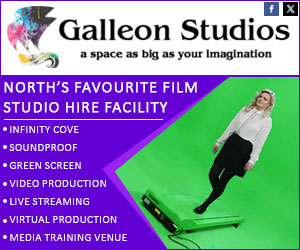Broadcast News
31/10/2012
Cloud Computing – The Hype, The Problems, The Dangers And The Doubts
No media cloud on the immediate horizon: George Jarrett talks to industry contacts about the problems that have to be resolved before broadcasters and post houses will trust the cloud
Back in the 1960’s I used to smoke Passing Cloud cigarettes. I also sang along to ‘Get off of My Cloud’ by the Rolling Stones, and both of those memories dominated a flippant approach to the cloud.
But all of a sudden we have wall-to-wall conferences, and dozens of vendors inviting you to hold their hand as you step nervously out onto Cumulus Nimbus, perhaps buoyed by some experience of using Google Docs. It is time to take the cloud seriously, but first we have to identify the thorny technological and green issues that still have to be addressed, and to identify some of the best connections for seeking ongoing help.
One of the very best is the EBU, which is staging Out of the Cloud, into the Light (November 20-21).
The first interview features one of the main figures behind the production of this important event, and later in the piece, the DTG unveils its approach to the cloud. Like HD when it emerged, cloud computing has a lot of formations to come.
Chris Chambers of BBC Future Media/EBU - Head of Media Network Integration Laboratory, R&D South
Some people are desperate for a business case, and are trying to sell existing technology under a new buzz banner. Does he agree?
“Yes; so desperate that they ignore a number of fundamental issues when trying to utilize existing technology and current workflows, and are endangering any real value,” he said.
Surely people with uncompressed files will balk at paying for the bandwidth costs both ways, and for the CPU and the storage on top. “A big yes,” said Chambers. “It is not just uncompressed media which is a particular issue for us, but ‘big data’ in general. Cloud solutions are hyped often as a stand alone solution that will "solve all your problems" without even addressing the need to bolster the infrastructure and the potentially very significant cost this will bring to any workable outcomes.
“The communities addressing cloud are not thinking holistically enough about what they are doing, and where cloud will bring benefits overall,” he added. “We are looking at using an open source dashboard, - we are currently studying Open Stack - and then requiring any potential cloud products to use that as a basic API even if they produce a proprietary management interface too. “We must be able to specify best practice and have some common deployment and management points otherwise it will be chaos and virtually impossible to manage particularly in large organisations,” he added. “Unless of cause it all comes from a single source; but then the resulting business risks could be massive.”
The biggest issue for broadcasters going for the cloud is finding the right business model surely? “Yes. However, the problem is that making great media is not like making baked bean tins. There is more than one way of supporting the creative processes of producing media and while few if any, with the possible exception of the film industry, could afford an unrestricted approach to media creation, there needs to be a range of options to allow people to work in varied ways and be creative,” said Chambers. “Also, depending on each remit and topography, broadcasters will quite likely need slightly differing business models, and the workflows they support. There is not a single answer so we all need to understand our business and workflow requirements and understand that if we restrict how our people work, we will end of with "baked bean tin" content, just with a different label.”
Cloud could fall foul of carbon taxes if governments examine its green credentials. “Until we improve the efficiency of network transport protocols, particularly at 40G and above, find a drastically different approach to storage structures, and have a service demand management structure that goes from the protonic layer to the service API, cloud will fall foul of any green credentials,” said Chambers. “Moving interactive media with an ever-expanding quality and feature profile on IT networks, storage and broadband is several orders of magnitude more inefficient in energy terms than more traditional models of delivery,” he added. “If we are going to deliver the future without using several cities worth of energy, we have very serious work to do!”
Bruce Devlin, CTO of Amberfin
“In ten years’ time everything will be cloud based. Now there are only two companies using Amberfin technology in the cloud, so I am looking at business models so we can remain successful and not be a fall guy,” he said. “The problem is that there is an enormous amount of marketing concerning cloud computing. It could be the best thing or the worst thing for you.
“Imagine you are a small or medium-sized media owner with diverse sets of customers trying to get at your content. The sensible thing is to put it with Amazon, run the distribution software in the cloud, and rely on the Amazon background to do all the delivery,” he added. “Because it is not a massive archive, it is not a heavy cost. And your customers are paying you on a transactional basis. You would pay Amazon on a transactions based deal for the CPU, the network bandwidth, and the storage. You could calculate what each transaction would return and so cloud would make business sense to you.
“But it makes no sense at all presently to the top tier broadcaster or filmmaker, because they have absolute paranoia about the security of their uncompressed files,” he continued. “And then there is the cost of getting into the cloud: you pay the bandwidth costs both ways, and you pay for the CPU and your storage, so for most people in that area it makes more sense to keep the infrastructure in house. Downstream, cloud might make more sense.”
Then there is grinding the top off the peak – meaning peak demand prior to Christmas and the summer season.
“There is a sensible hybrid model – big enough internally to handle most demand, plus cloud capacity. Most broadcasters will end up doing this, just renting kit for the peaks,” said Devlin.
“But it is no good halving costs if it means taking a terrible risk,” he added. “The biggest issue for broadcasters going for the cloud is finding the right business model and making it work for everyone across five or six layers of corporate involvement.
“There are a gazillion cloud applications, but no best practise – not even a dashboard to view how well the cloud is performing,” he added. “Data centres do go down, and 99.99% reliability will not impress broadcasters.”
Back in the 1960’s I used to smoke Passing Cloud cigarettes. I also sang along to ‘Get off of My Cloud’ by the Rolling Stones, and both of those memories dominated a flippant approach to the cloud.
But all of a sudden we have wall-to-wall conferences, and dozens of vendors inviting you to hold their hand as you step nervously out onto Cumulus Nimbus, perhaps buoyed by some experience of using Google Docs. It is time to take the cloud seriously, but first we have to identify the thorny technological and green issues that still have to be addressed, and to identify some of the best connections for seeking ongoing help.
One of the very best is the EBU, which is staging Out of the Cloud, into the Light (November 20-21).
The first interview features one of the main figures behind the production of this important event, and later in the piece, the DTG unveils its approach to the cloud. Like HD when it emerged, cloud computing has a lot of formations to come.
Chris Chambers of BBC Future Media/EBU - Head of Media Network Integration Laboratory, R&D South
Some people are desperate for a business case, and are trying to sell existing technology under a new buzz banner. Does he agree?
“Yes; so desperate that they ignore a number of fundamental issues when trying to utilize existing technology and current workflows, and are endangering any real value,” he said.
Surely people with uncompressed files will balk at paying for the bandwidth costs both ways, and for the CPU and the storage on top. “A big yes,” said Chambers. “It is not just uncompressed media which is a particular issue for us, but ‘big data’ in general. Cloud solutions are hyped often as a stand alone solution that will "solve all your problems" without even addressing the need to bolster the infrastructure and the potentially very significant cost this will bring to any workable outcomes.
“The communities addressing cloud are not thinking holistically enough about what they are doing, and where cloud will bring benefits overall,” he added. “We are looking at using an open source dashboard, - we are currently studying Open Stack - and then requiring any potential cloud products to use that as a basic API even if they produce a proprietary management interface too. “We must be able to specify best practice and have some common deployment and management points otherwise it will be chaos and virtually impossible to manage particularly in large organisations,” he added. “Unless of cause it all comes from a single source; but then the resulting business risks could be massive.”
The biggest issue for broadcasters going for the cloud is finding the right business model surely? “Yes. However, the problem is that making great media is not like making baked bean tins. There is more than one way of supporting the creative processes of producing media and while few if any, with the possible exception of the film industry, could afford an unrestricted approach to media creation, there needs to be a range of options to allow people to work in varied ways and be creative,” said Chambers. “Also, depending on each remit and topography, broadcasters will quite likely need slightly differing business models, and the workflows they support. There is not a single answer so we all need to understand our business and workflow requirements and understand that if we restrict how our people work, we will end of with "baked bean tin" content, just with a different label.”
Cloud could fall foul of carbon taxes if governments examine its green credentials. “Until we improve the efficiency of network transport protocols, particularly at 40G and above, find a drastically different approach to storage structures, and have a service demand management structure that goes from the protonic layer to the service API, cloud will fall foul of any green credentials,” said Chambers. “Moving interactive media with an ever-expanding quality and feature profile on IT networks, storage and broadband is several orders of magnitude more inefficient in energy terms than more traditional models of delivery,” he added. “If we are going to deliver the future without using several cities worth of energy, we have very serious work to do!”
Bruce Devlin, CTO of Amberfin
“In ten years’ time everything will be cloud based. Now there are only two companies using Amberfin technology in the cloud, so I am looking at business models so we can remain successful and not be a fall guy,” he said. “The problem is that there is an enormous amount of marketing concerning cloud computing. It could be the best thing or the worst thing for you.
“Imagine you are a small or medium-sized media owner with diverse sets of customers trying to get at your content. The sensible thing is to put it with Amazon, run the distribution software in the cloud, and rely on the Amazon background to do all the delivery,” he added. “Because it is not a massive archive, it is not a heavy cost. And your customers are paying you on a transactional basis. You would pay Amazon on a transactions based deal for the CPU, the network bandwidth, and the storage. You could calculate what each transaction would return and so cloud would make business sense to you.
“But it makes no sense at all presently to the top tier broadcaster or filmmaker, because they have absolute paranoia about the security of their uncompressed files,” he continued. “And then there is the cost of getting into the cloud: you pay the bandwidth costs both ways, and you pay for the CPU and your storage, so for most people in that area it makes more sense to keep the infrastructure in house. Downstream, cloud might make more sense.”
Then there is grinding the top off the peak – meaning peak demand prior to Christmas and the summer season.
“There is a sensible hybrid model – big enough internally to handle most demand, plus cloud capacity. Most broadcasters will end up doing this, just renting kit for the peaks,” said Devlin.
“But it is no good halving costs if it means taking a terrible risk,” he added. “The biggest issue for broadcasters going for the cloud is finding the right business model and making it work for everyone across five or six layers of corporate involvement.
“There are a gazillion cloud applications, but no best practise – not even a dashboard to view how well the cloud is performing,” he added. “Data centres do go down, and 99.99% reliability will not impress broadcasters.”
Top Related Stories
Click here for the latest broadcast news stories.
14/04/2014
Cloud Media Services: Adopting The Cloud And Making It Work
Richard Welsh, SMPTE International Governor and CEO at Sundog Media Toolkit, discusses the ever-evolving landscape of content-delivery. The biggest ap
Cloud Media Services: Adopting The Cloud And Making It Work
Richard Welsh, SMPTE International Governor and CEO at Sundog Media Toolkit, discusses the ever-evolving landscape of content-delivery. The biggest ap
08/06/2018
The Crucial Values Of A Cloud Native Architecture
After an NAB that was riddled with cloud native technology, and people saw the huge merits of micro services plus the massive potential of AI, it was
The Crucial Values Of A Cloud Native Architecture
After an NAB that was riddled with cloud native technology, and people saw the huge merits of micro services plus the massive potential of AI, it was
17/12/2024
Alibaba Cloud Named Leader in The Forrester Wave™: Public Cloud Platforms Q4 2024 Report
Alibaba Cloud has recently been named a Leader in The Forrester Wave™: Public Cloud Platforms Q4 2024 report. Alibaba Cloud believes this designation
Alibaba Cloud Named Leader in The Forrester Wave™: Public Cloud Platforms Q4 2024 Report
Alibaba Cloud has recently been named a Leader in The Forrester Wave™: Public Cloud Platforms Q4 2024 report. Alibaba Cloud believes this designation
12/08/2024
Alibaba Cloud Harnesses The Power Of Its Cloud Technologies
Alibaba Cloud has harnessed the power of its cloud technologies to drive multiple initiatives throughout the Olympic Games Paris 2024 (Paris 2024). Th
Alibaba Cloud Harnesses The Power Of Its Cloud Technologies
Alibaba Cloud has harnessed the power of its cloud technologies to drive multiple initiatives throughout the Olympic Games Paris 2024 (Paris 2024). Th
26/07/2024
Alibaba Cloud And OBS Announces Launch Of OBS Cloud 3.0
Alibaba Cloud and Olympic Broadcasting Services (OBS) have announced the launch of OBS Cloud 3.0 for the Olympic Games Paris 2024 (Paris 2024). A comb
Alibaba Cloud And OBS Announces Launch Of OBS Cloud 3.0
Alibaba Cloud and Olympic Broadcasting Services (OBS) have announced the launch of OBS Cloud 3.0 for the Olympic Games Paris 2024 (Paris 2024). A comb
18/02/2019
Masstech To Demonstrate Range Of Cloud And Hybrid Cloud Storage At CABSAT 2019
Masstech has announced that at CABSAT 2019, the company will demonstrate to broadcasters in the Middle East its full range of highly-optimised cloud a
Masstech To Demonstrate Range Of Cloud And Hybrid Cloud Storage At CABSAT 2019
Masstech has announced that at CABSAT 2019, the company will demonstrate to broadcasters in the Middle East its full range of highly-optimised cloud a
01/11/2018
Alibaba Cloud Successfully Tests Components Of OBS Cloud Service Platform
Alibaba Cloud has successfully tested the important components of the OBS Cloud service platform during the 2018 Summer Youth Olympic Games (YOG), hel
Alibaba Cloud Successfully Tests Components Of OBS Cloud Service Platform
Alibaba Cloud has successfully tested the important components of the OBS Cloud service platform during the 2018 Summer Youth Olympic Games (YOG), hel
07/06/2018
Cloud Is No Broadcast Cure All
Telestream's new CMO, Chris Osika, explains the company's position on cloud deployments within the broadcast industry. In broadcasting, cloud-based wo
Cloud Is No Broadcast Cure All
Telestream's new CMO, Chris Osika, explains the company's position on cloud deployments within the broadcast industry. In broadcasting, cloud-based wo
31/01/2018
Powering Cloud-Based Production With Avid MediaCentral
Extending media production to the cloud drives seamless collaboration, widespread efficiencies and streamlines internal operations. By Craig Dwyer – S
Powering Cloud-Based Production With Avid MediaCentral
Extending media production to the cloud drives seamless collaboration, widespread efficiencies and streamlines internal operations. By Craig Dwyer – S
26/01/2024
Cobalt Iron Earns Another New Patent
Cobalt Iron has earned another new patent, this time on its technology for data locality-based brokering of cloud computing operations. Patent No. 118
Cobalt Iron Earns Another New Patent
Cobalt Iron has earned another new patent, this time on its technology for data locality-based brokering of cloud computing operations. Patent No. 118
18/09/2017
Marquis Broadcast Transforms Its Business With Hybrid Cloud Production
The company aims to decouple people and operations from infrastructure and technical complexity. There's been a big shift in the industry recently, fr
Marquis Broadcast Transforms Its Business With Hybrid Cloud Production
The company aims to decouple people and operations from infrastructure and technical complexity. There's been a big shift in the industry recently, fr
16/09/2019
Qvest Media Brings Trend-Setting Solutions To IBC
Qvest Media has made a statement at this year's IBC Show with demonstrations around its popular lineup of cloud solutions. Demonstrating on Stand 3.B4
Qvest Media Brings Trend-Setting Solutions To IBC
Qvest Media has made a statement at this year's IBC Show with demonstrations around its popular lineup of cloud solutions. Demonstrating on Stand 3.B4
18/03/2022
Paramount Global Utilizes Avid's Managed Cloud
Avid has announced an expansion of its managed cloud solution and an agreement with Paramount Global, one of the world's largest providers and produce
Paramount Global Utilizes Avid's Managed Cloud
Avid has announced an expansion of its managed cloud solution and an agreement with Paramount Global, one of the world's largest providers and produce
24/01/2024
Sony's Ci Media Cloud Updates Its Offerings
Ci Media Cloud, a cloud-based media management and collaboration solution from Sony that allows users to capture, backup, review, transform and run st
Sony's Ci Media Cloud Updates Its Offerings
Ci Media Cloud, a cloud-based media management and collaboration solution from Sony that allows users to capture, backup, review, transform and run st
14/09/2023
swXtch.io Helps Companies Migrate High-Volume Media Workflows To The Cloud
swXtch.io is returning to IBC with strong momentum behind its vision for helping media and entertainment companies migrate high-volume media workflows
swXtch.io Helps Companies Migrate High-Volume Media Workflows To The Cloud
swXtch.io is returning to IBC with strong momentum behind its vision for helping media and entertainment companies migrate high-volume media workflows















